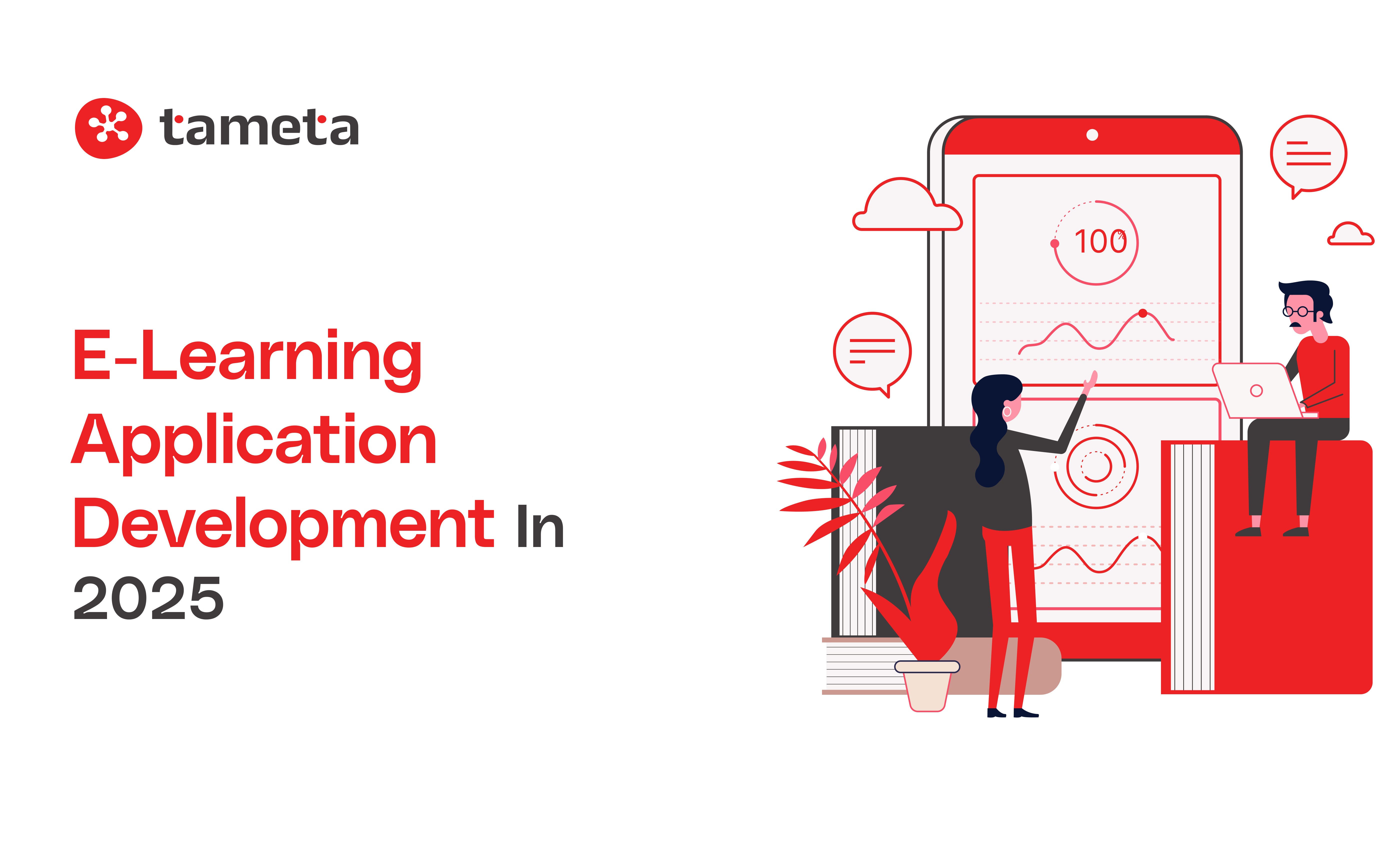Introduction
Education is undergoing a major transformation with the rapid growth of digital learning. In 2025, e-Learning Application Development will not just be an option but a necessity for schools, universities, and education-based startups. The increasing demand for online education app development is driving institutions and businesses to invest in e-learning mobile app development, ensuring that learning is engaging, interactive, and accessible from anywhere.
With advancements in technology, e-learning applications are integrating AI, VR, and gamification to enhance user experience. Whether you are a school administrator or an entrepreneur planning to launch an education startup, this guide will equip you with all the insights you need. We will explore the entire development process, key benefits, essential features, cost considerations, challenges, and the latest trends in e-Learning Application Development in 2025.
Why e-Learning Applications are Important in 2025?
The online education industry is booming, and statistics show its rapid growth:
-
The global e-learning market is expected to reach $400 billion by 2026 (Source: Global Market Insights).
-
Over 90% of students now prefer online learning due to its flexibility and accessibility (Source: eLearning Industry).
-
Schools and universities worldwide are adopting e-learning mobile app development to improve learning outcomes.
Note: Schools and educational startups must embrace digital learning to stay competitive and meet the needs of modern students.
Benefits of e-Learning Applications

1. Flexibility & Accessibility
One of the biggest advantages of e-learning mobile app development is its flexibility. Students can learn anytime, anywhere, eliminating geographical barriers. Unlike traditional classroom learning, e-learning platforms enable learners to access educational materials from the comfort of their homes, on mobile devices, or even while traveling. This feature is particularly beneficial for working professionals, students in remote locations, and those with disabilities.
2. Cost-Effective Education
Institutions save significantly on infrastructure costs by delivering education online. Traditional education involves expenses such as building maintenance, classroom equipment, utilities, and teacher salaries. With online education app development, schools and universities can cut down on these costs and allocate funds towards improving digital infrastructure, hiring expert educators, and enhancing course content. For students, e-learning reduces travel expenses, accommodation costs, and the need for expensive textbooks, making education more affordable.
3. Personalized Learning
AI-powered e-learning applications provide customized learning experiences based on student performance. Unlike a one-size-fits-all approach in traditional education, AI-driven platforms analyze each student’s strengths and weaknesses to offer personalized course recommendations, adaptive assessments, and tailored learning paths. Features like AI tutors and chatbots enhance engagement by providing instant doubt resolution and feedback.
4. Increased Engagement
Interactive quizzes, videos, and gamified learning keep students engaged. Traditional classroom learning often relies on passive teaching methods, leading to a lack of motivation among students. However, e-learning mobile app development incorporates multimedia elements such as animation, simulations, live discussions, and gamified assessments, making learning more enjoyable and effective. Features like leaderboards, badges, and reward points encourage students to complete courses and achieve milestones.
5. Scalability
Educational startups can scale their platforms to accommodate more students without additional physical space. Unlike traditional schools and universities that have limited seats due to physical constraints, e-learning applications allow an unlimited number of learners to enroll in courses. Cloud-based infrastructure enables institutions to scale their servers based on demand, ensuring smooth performance even during peak usage.
6. Self-Paced Learning
Unlike traditional classrooms where students must follow a fixed schedule, online education app development allows self-paced learning. This is especially beneficial for students who have different learning speeds. Learners can pause, rewind, and re-watch video lectures, revisit notes and take assessments at their own convenience. This flexibility ensures better comprehension and knowledge retention.
7. Improved Teacher-Student Interaction
Contrary to the myth that online learning reduces teacher-student interaction, modern e-learning applications facilitate better communication through discussion forums, Q&A sessions, live chat, and one-on-one video calls. AI-based chatbots and virtual tutors further assist students in understanding complex concepts, ensuring a seamless learning experience.
8. Global Learning Community
E-learning platforms create opportunities for students from different parts of the world to learn together. With the rise of e-learning mobile app development, geographical boundaries are no longer a limitation. Learners can connect with industry experts, peers, and instructors from around the globe, gaining diverse perspectives and cultural insights. Virtual study groups and online communities foster collaboration and knowledge-sharing among students.
9. Eco-Friendly Learning
Online learning significantly reduces the need for physical resources such as paper, books, and printed materials. Digital education contributes to environmental sustainability by minimizing carbon footprints associated with transportation, school infrastructure, and resource production. By adopting e-learning applications, institutions promote eco-friendly learning practices.
10. Real-Time Performance Analytics
Data analytics plays a crucial role in e-learning mobile app development. Institutions can track student progress through real-time performance analytics, identify learning gaps, and offer personalized support. Educators can monitor engagement levels, quiz scores, and course completion rates, enabling data-driven decision-making for curriculum improvements.
11. Enhanced Security & Data Protection
Security is a top concern in online education. Modern e-learning applications integrate robust security protocols, including end-to-end encryption, multi-factor authentication, and secure payment gateways. Cloud-based storage ensures safe data backup, protecting sensitive student information from cyber threats.
12. Offline Learning Capability
One of the most crucial features in e-learning mobile app development is the ability to access content offline. Many learners, especially in remote areas with unstable internet connections, benefit from this functionality. Downloadable course materials, recorded lectures, and offline assessments allow students to continue learning without internet dependency.
Remember: e-Learning mobile app development benefits not only students but also schools and businesses by reducing costs, increasing accessibility, and enhancing the overall learning experience. Investing in online education app development is the key to staying ahead in the digital education era.
Types of e-Learning Applications
-
Learning Management System (LMS) – For managing online courses and student progress.
-
Virtual Classrooms – Live classes with interactive features like chat, screen sharing, and whiteboards.
-
Corporate Training Apps – Used by companies to train employees remotely.
-
Skill-Based Learning Apps – Apps like Coursera and Udemy focus on specific skills.
-
Exam Preparation Apps – For students preparing for competitive exams.
-
K-12 Learning Apps – Targeted at primary and secondary school students.
-
Language Learning Apps – Apps like Duolingo help users learn new languages interactively.
“Technology will never replace great teachers, but technology in the hands of great teachers can be transformational.” – George Couros
Features Every e-Learning App Must Have
1. User-Friendly Interface
-
Simple navigation for students and teachers.
-
Multi-device compatibility (mobile, tablet, desktop).
2. Interactive Content
-
Videos, PDFs, animations, and quizzes.
-
Gamification for engagement.
3. Live Classes & Video Conferencing
-
Integration with Zoom, Google Meet, or in-app video conferencing.
-
Real-time interaction between students and teachers.
4. AI-Powered Personalization
-
Adaptive learning paths based on student performance.
-
AI chatbots for instant support.
5. Multi-Language Support
-
To reach a broader audience, especially in diverse regions.
6. Secure Payment Gateway
7. Push Notifications
-
Alerts for new courses, assignments, and live sessions.
8. Analytics & Reporting
-
Performance tracking for students and teachers.
9. Offline Mode
-
Allows students to download lessons and study without the internet.
10. Parental Control & Monitoring
-
Essential for school apps targeting younger students.
11. AI-Based Auto-Assessment
-
Automated grading and performance reports.
12. Discussion Forums & Peer Learning
-
Encourage collaborative learning among students.
Advanced Technologies in e-Learning Application Development

1. Artificial Intelligence (AI)
-
Personalized course recommendations.
-
AI-based tutors to assist students.
2. Augmented Reality (AR) & Virtual Reality (VR)
-
Immersive learning experiences for practical subjects.
-
3D simulations for science and engineering students.
3. Blockchain for Certification
-
Secure and verifiable digital certificates for course completion.
4. Internet of Things (IoT)
-
Smart classrooms and connected learning environments.
5. Adaptive Learning
-
Dynamic adjustments in curriculum based on student progress.
Best Monetization Strategies for e-Learning Apps
-
Subscription-Based Model – Monthly/annual fees for accessing content.
-
Freemium Model – Free content with premium features.
-
Pay-Per-Course – One-time payments for specific courses.
-
Corporate Licensing – Selling course access to organizations.
-
Affiliate Marketing & Partnerships – Promoting third-party educational tools.
Tip: Choose a revenue model based on your target audience and content strategy.
Also Read - How to Develop School Management Software - Complete Guide
e-Learning App Development Cost Breakdown
Development Cost by Complexity
-
Basic App: $15,000 - $30,000
-
Medium Complexity App: $30,000 - $80,000
-
Advanced Platform: $80,000 - $200,000+
Factors Affecting Cost
-
Features & Functionalities – More features increase costs.
-
Design & UI/UX Complexity – Custom animations and designs raise development time.
-
Development Team Location – Offshore teams can be cost-effective.
-
Technology Stack – Advanced tech like AI & VR increases budget.
Note: Hiring an experienced app development company ensures cost-effective and high-quality solutions.
Future Trends in e-Learning App Development
-
AI-Powered Tutors – Personalized learning assistance.
-
Virtual & Augmented Reality – Immersive learning experiences.
-
Blockchain for Certification – Secure and verifiable credentials.
-
Microlearning Modules – Short, bite-sized lessons.
-
Gamification & Social Learning – Increasing engagement through competitive elements.
-
Cloud-Based Learning Systems – On-demand, scalable education platforms.
-
Voice-Activated Learning – AI-powered voice assistants for hands-free learning.
FAQS
1. What is an e-learning application?
- An e-learning application is a digital platform where students can learn online. It provides videos, quizzes, and interactive lessons to make learning easy and fun.
2. Why do schools and businesses need e-learning apps?
- E-learning apps help schools and businesses teach students and employees without a physical classroom. They are flexible, cost-effective, and allow learning from anywhere.
3. What are the key features of a good e-learning app?
A good e-learning app should have:
-
Easy-to-use design
-
Videos and quizzes
-
Live classes
-
Personalized learning
-
Offline learning mode
-
Secure payments for paid courses
4. How much does it cost to develop an e-learning app?
- The cost depends on the features you need. A simple app may cost around $15,000, while an advanced app with AI and VR features can cost over $100,000.
5. Can small schools afford e-learning apps?
- Yes! Many budget-friendly options are available. Schools can start with a basic version and add features later.
Conclusion
In 2025, e-Learning Application Development will continue to transform the education sector. Schools, startups, and educational institutions must leverage online education app development to stay ahead in the digital age. With the right strategy, technology, and development team, your e-learning mobile app development project can create a meaningful impact.
Looking to build an e-learning app? Partner with a trusted app development company to turn your vision into reality!
Build Your e-Learning App with Tameta Tech!
Want to create an amazing e-learning app? Tameta Tech is your perfect app development partner! We build easy-to-use, engaging, and powerful learning apps for schools and startups. Let’s turn your education idea into reality!
Contact us today! Your digital learning future starts now.
Remember: The future of education is digital – invest in e-learning application development today!








